How to groom a dog at home
22nd April, 2024
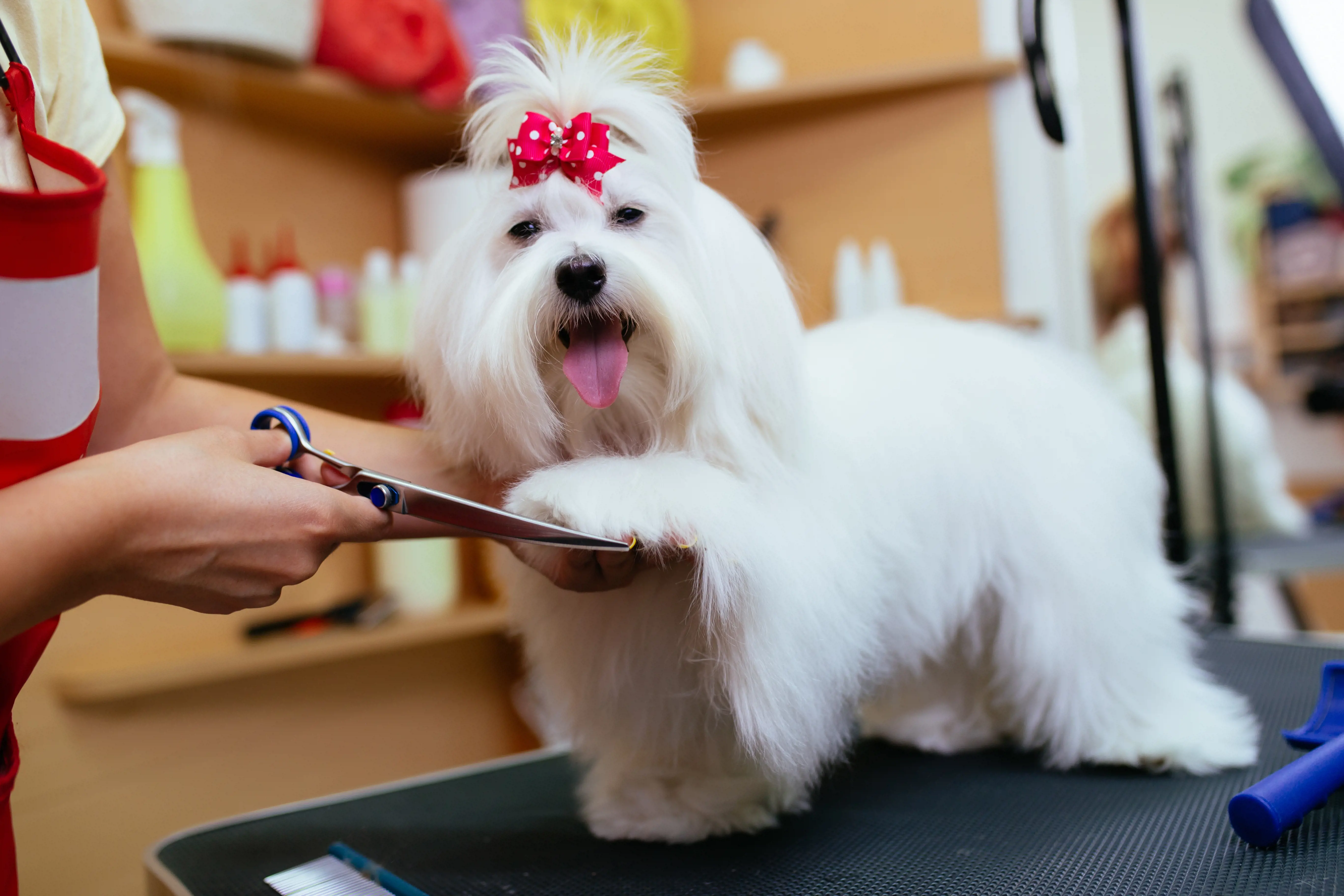
Keeping your dog’s coat sleek and clean isn’t just an aesthetic benefit – it’s good for your dog’s overall health too.
Not only does regular grooming keep dirt, germs, and other bacteria at bay but it’s also an effective way to get to know your dog’s body, so you can quickly identify any lumps, bumps, and changes.
But on a day-to-day basis, a clean coat makes it more enjoyable to snuggle with our furry friends.
So, washing, brushing, and even cutting your dog’s hair at home in between bookings at the puppy parlour works in everyone's favour.
Why is it important to groom my dog?
Grooming is vital to protect your dog’s coat getting matted, as well as removing dead hair, dirt, and dandruff.
Brushing also stimulates the natural oils in the skin and fur, which helps make for a glossy, healthy coat.
But grooming isn’t just about brushing your dog’s fur, it’s also a chance to check for any unusual lumps or bumps and give them a general health check.
You can use it as an opportunity to check for any signs of fleas or ticks, inspect their teeth, eyes and ears and make sure their claws aren’t overgrown.
When to start grooming your dog
Throughout a dog’s lifetime, they will require regular grooming so owners should try to introduce a grooming regime at the earliest opportunity, ideally as a puppy.
By slowly familiarising your dog to grooming equipment, this will not only improve their welfare but also make it easier for you and them in the future, when they may need to be handled by a vet.
Grooming sessions should be a relaxing and enjoyable experience for your dog.
It’s important to ensure that you’re always assessing your dog’s body language for signs that they may be uncomfortable or avoiding being touched.
Can I clip my dog myself?
Clipping is the process of using dog clippers and a blade to shave the dog short. The clippers can be used over the body, down the legs and around the face.
Depending on the length, thickness of coat and also whether the dog is matted, will determine the length of blade to use.
Remember that the handling and comfort of your dog is paramount. Dogs should not be manoeuvred in a rough or harsh manner.
If you have trouble with your dog wiggling, then it can be a good idea to rope in a friend or family member, to help keep your dog still by giving some treats as a reward for being still.
Sometimes dogs don’t mind their bodies being clipped however they will wriggle when the legs are being done or feet being trimmed, for example.
If your dog is getting restless it might be better to do a little bit at a time and then give the dog a break and coming back to it bit by bit until that section has been finished.
How to use Clippers
So, you now have your dog grooming clippers and the appropriate dog grooming blades for the length of coat you prefer your dog to have.
Once you have put the applicable blade onto the clippers and plugged the clippers into the power point (unless you are using battery operated clippers) you are ready to start clipping your dog.
Remember – do not attach or detach any blade while the clipper is running!
Once the blade is in position, switch the clippers on and hold them comfortably in your hand.
Hold the clippers so that the flat side of the blade runs along the surface of the dog’s body. You can start your clip anywhere on the dog’s body; however, it is easier to follow the same clipping pattern and routine each time.
This may help your dog to get used to being clipped, plus help them feel a little more relaxed each time you do the job.
The clippers should glide through the coat without too much pressure, unless the dogs coat is very matted or thick coated. In which case you may need to gently exert a little pressure to get the blade through the thickness.
Always keep the clipper blade flat against the body of the dog, otherwise you may end up cutting into the skin. Blades are very sharp and can easily cut if they are not kept level.
The danger spots for cutting into the skin is on the legs and the very thin folds of skin as you stretch the leg out however, unless you are careful, it is possible to cut the dog anywhere on the body.
Some dogs may not tolerate grooming at all, and this can be very difficult as it may need two people to work with the dog or at the very worst the dog may need to be taken to a vet for sedating. This then becomes an expensive exercise.
With the right preparation from puppyhood and training, your dog should learn to accept grooming as a part of life.
How do I know if my dog's nails need to be clipped?
How often to trim dogs’ nails is key to keeping canines happy and healthy.
Unfortunately, many owners even those who love their pooches deeply, overlook nail trimming. This can leave many dogs with overgrown nails and a host of uncomfortable and painful complications.
Overgrown nails can cause discomfort, pain, and even affect their ability to walk or run properly.
It’s important to keep an eye on your dog’s nails to ensure they are not getting too long. Here are some signs that your dog’s nails may need trimming:
- You can hear your dog’s nails clicking on the floor when they walk.
- Your dog’s nails are touching the ground when they stand or walk.
- Your dog is having difficulty walking or standing on hard surfaces.
- Your dog’s nails are curling or growing into their paw pads.
- Your dog is constantly licking or chewing their paws.
- Your dog’s nails are visibly too long.
If you notice any of these signs, it’s time to trim your dog’s nails. As we observed earlier, neglecting to trim your dog’s nails can lead to discomfort, pain, and even infections.
Nail Trimming at Home
On the face of it clipping your dog’s nails is a straightforward task, but to ensure you are clipping safely we recommend adhering to a specific process.
It goes without saying though, if the thought of canine nail clipping fills you or your pet with anxiety, we would recommend consulting a professional for advice or enlisting them to do the trimming if you are not confident.
Take a look at this comprehensive guide from the DogsTrust on cutting your dog’s nails.
Bathing at Home
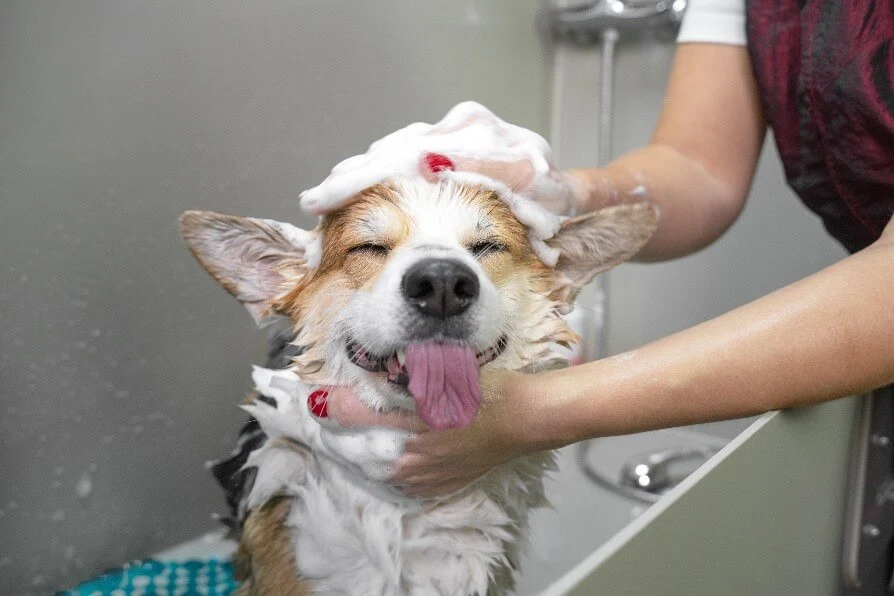
Is the Eau de Dogue getting a bit too much to handle? While some dogs don’t mind a warm, soapy bath, there are other dogs who’ll try anything to avoid being in the tub. Whichever category your dog falls into, it’s always good to know how to bathe a dog to avoid creating a big mess in the bathroom.
Unlike us, dogs don’t need daily baths. That said, bathing your dog regularly is a good idea. How often you should bathe your dog depends on the type of dog you have.
The good news is that long-haired dogs rarely need more than two to three baths a year, as too much bathing actually removes the natural oils from his coat. A quick paw wash will do most of the time but if your dog has a medical condition, has rolled in something unpleasant, or just smells a bit ‘off,’ then a bath is probably on the cards.
Most short-haired dogs can also go without being bathed for a long time, unless they get particularly dirty or smelly! For the majority of short-haired dog breeds, bathing once a month is often enough.
Preparation
Before you turn on those taps, it helps to get all the preparation sorted. Here’s what you’ll need to do to give a dog a bath!
Buy Dog Shampoo
It’s important that you only use specially formulated dog shampoo instead of human shampoo. Ideally, you should try to find a shampoo that has a neutral PH balance. Also try to pick a shampoo that doesn’t have artificial colours or fragrances.
Choose the Right Spot!
If you have a small breed dog, then you can bathe them in a sink. Larger dogs will need more space so choosing somewhere such as a shower or bathtub can work well. Make sure you provide your dog with some grip, place a towel or rubber bathmat on the bottom of the tub or sink. Not all dogs like baths, so it’s also a good idea to choose a location where your dog feels safe and secure.
Get Everything Set Up
Before even beginning the dog bathing process, arrange everything you need neatly by the washing area. You’ll need plenty of clean towels for afterwards, and it helps to keep the doors closed to stop your dog bolting for the sofa as soon as you’re done.
The ‘Mane’ Event: Bathing
Follow this step-by-step guide to give your dog a bath without too much drama.
Reassure your dog
Lots of dogs don’t like being given a bath so it's important to let them know that you’ve got their best interests at heart. Talk to them in a reassuring voice before, during and after the bath. You could also give your dog a treat after a successful dog bath!
- Brush your dog first: This is to ensure that there are no tangles or matted fur. Matted hair holds water which can leave you dog with irritated skin.
- Test the water temperature: Keep the water at a warm temperature and make sure you test it before washing your dog.
- Wet your dog’s body: Soak your dog’s body in warm water and ensure their fur is nice and wet, especially underneath.
- Add the dog shampoo: Squeeze out a small amount and rub the shampoo into the body until it lathers. Do not apply shampoo to your dog’s head or face as you risk getting shampoo in your dog’s eyes.
- Wipe your dog’s face: If your dog’s face is also dirty, then you should wipe it with a damp cloth but don’t get shampoo or soap on their face.
- Rinse your dog: It’s important to rinse your dog thoroughly with warm water. Excess soap can irritate your dog’s skin, so it’s important to be rigorous with the rinsing.
- Dry your dog: Use a towel to dry your dog thoroughly after the bath. You can also use a blow-dryer to dry your dog but make sure it’s on the coolest setting, hold far away from their skin and keep it moving so you don’t focus it on one spot too long.
- Reward your dog: After you’ve bathed your dog it’s important to reward them with vocal praise. It’s also a good idea to give your dog a treat too so they know you appreciated their co-operation.
Brushing at Home
You should brush your dog at least a few times each week, helping to keep their coats and skin as healthy as possible.
You can use this as part of a regular grooming technique, taking time to bond with your four-legged friend, whilst checking for things like, fleas, ticks, lumps, and bumps.
You may find that as the weather warms up, they shed more, so you can increase the frequency of dog brushing to remove loose hair. Essentially, you should base it on your dog’s individual requirements, but as a guide, a few times a week is a great starting point.
This guide covers the 10 things all dog owners should know about brushing their pets coat!
Ear Cleaning at Home
Most dogs don’t need their ears cleaned regularly, so unless you notice a problem its best to leave them alone!
However, if your dog suffers from very waxy/dirty ears or gets ear infections regularly, it may help them from time to time.
Always speak to your vet before cleaning your dog’s ears to make sure they don’t need any medication beforehand.
What you’ll Need:
- Ear cleaner for dogs
- Cotton wool
- Gloves
- Treats
How to clean my dog’s ears
- Look inside your dog’s ears - if they look red, inflamed, seem painful or smell pungent, contact your vet before cleaning them, as they may have a problem (such as an ear infection or ear mites) that needs treatment before they can be cleaned
- Put gloves on and get ready with your ear cleaner, cotton wool and some treats for your dog
- Place the nozzle of the ear cleaner bottle into the entrance of your dog’s ear
- Squeeze some liquid out of the bottle (one big squeeze is usually enough), put the bottle to one side and gently massage the base of the ear to loosen up any dirt or wax
- Let your dog shake their head (watch out for any flying liquid!), then use cotton wool to wipe away any dirt from the entrance of their ear. NEVER use a cotton wool bud, as you risk pushing dirt further into the ear, or popping the eardrum if you push it in too far
- Reward your dog with a treat afterwards to make it a positive experience for them
Choosing the right groomer for my dog
Although the dog grooming industry is currently unregulated, there are a number of things that you can consider when choosing a reputable groomer, which will help you to be confident that they will meet your pet’s needs.
Have a look at this guide by the RSPCA to help you find a great groomer for your pooch.
Coat trimming
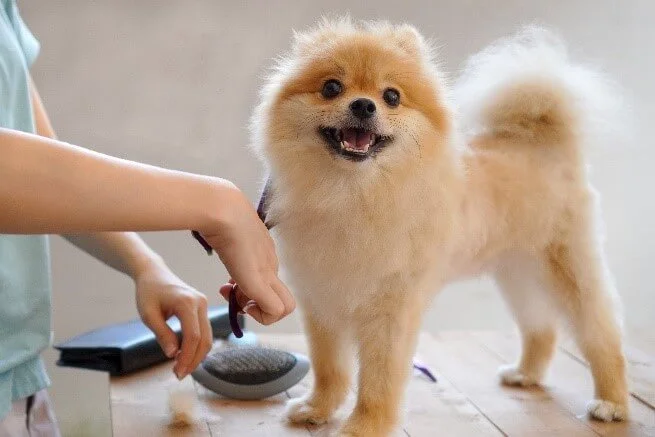
Everyone has a bad hair day once in a while, but you can prevent this problem with your dog by trimming their coat when necessary. Certain types of dog coats need to be trimmed to keep them in shape and looking great, including medium- to long-coated dogs, curly-coated dogs, and wire-haired dogs.
Medium to Long Coats
Get a comfortable pair of scissors. Trim the bottom of your dog’s coat after you’ve bathed them. Only take off a little bit at a time so that you get the look you want while keeping the length even. Follow up by trimming around the eyes and ears, using special scissors designed for those sensitive areas.
Curly Coats
Curly-coated dogs have many specialized cuts for their type of hair. Some are complex and best left to professional groomers. However, you can keep the cut in shape in between grooming visits by investing in some clippers and asking your groomer to show you how to use them. Always trim after your dog has been thoroughly brushed and bathed.
Wire Coats
Wire-haired coats are stripped—a process in which dead hair is plucked out—to remove excess hair.
Done properly, stripping is not painful, but this is another specialized task you’ll need a groomer to demonstrate. Thinning scissors can help you trim your wire-haired dog.
You should also use the scissors to trim excess hair around the paws, head, and anus.
What are the best brushes or combs to use at home?
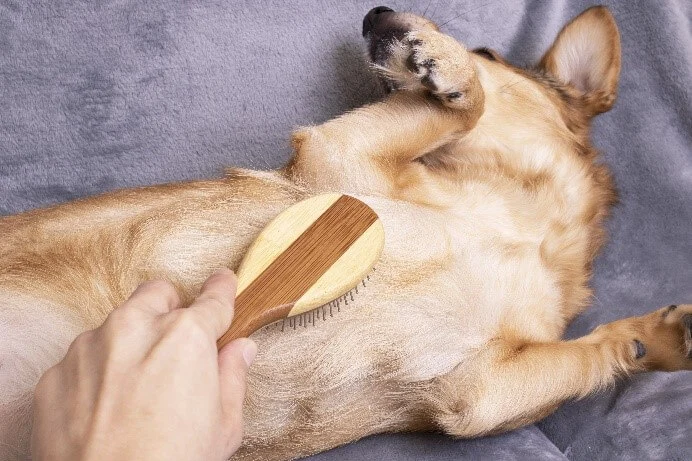
The brush or comb that you use for grooming your pet, will depend on the type of coat your dog has.
There are four major types of coats; the smooth or short hair, the wire hair, the long or curly-coated, and the double or triple coated.
- Each type of coat has its own characteristics, and each requires its own brush or comb.
- Bristle brushes are generally used on short or smooth coats.
- Wire pin brushes can work wonders on wiry or woolly fur.
- Slicker brushes are excellent at removing tangles or mats in medium to long hair.
- Combs are best used for general grooming purposes or to give a finishing to the groom
Bristle Brush
Bristle brushes feature tightly packed bristles, either natural or synthetic, and generally used on dogs with short coats and smooth hairs. They’re not good for detangling fur, but they’re ideal for removing loose hair on shorter coats and stimulating skin.
Wire Pin Brushes
With widely spaced wire pins and rubber tips, these brushes look a lot like human hairbrushes. They don’t do much for short-coated dogs, but they can work wonders on wiry or woolly fur. Despite their popularity, a wire pin brush shouldn’t be the only brush you use. Instead, use a wire pin brush for finishing off a grooming session.
Slicker Brushes
Slicker brushes are made up of short thin wires positioned closely together on a flat surface. They’re excellent at removing tangles and mats; dogs with medium and long coats are good candidates for this type of brush. Be careful, though, a slicker brush could scratch the dog’s skin if you use too much pressure.
Double-Ended Comb
The best type of comb for general grooming purposes is a double-ended comb between 8 and 9 inches long with two types of teeth: a fine section with close spacing and a coarse section where the teeth are set further apart.
Wide-Tooth Comb
This comb is a slightly longer version of the double-ended comb with teeth set widely apart.
Rubber Brushes/Grooming Mitts
You can use a rubber dog brush or grooming mitt on dogs with all kinds of coats. These products are designed more for massage and skin stimulation than they are for brushing, so they shouldn’t be the only brush you use. However, a rubber brush or a grooming mitt can help remove some loose fur, and most dogs love the sensation.
What should I do if my dog is scared of grooming or being brushed?
A negative association can develop, because the longer the period of time between brushes, the more uncomfortable it can be for them; he more out of condition their coat becomes the more unpleasant it can become for them to be touched or stroked, let alone bathed or brushed.
In extreme cases, this can then have a negative impact on the way they perceive human interaction altogether. So, it’s crucial that you get a handle on the problem as soon as possible and tackle it in the right way that’s best for your dog.
If your dog is scared of being brushed, try taking a few steps back. Get out a few brushes but don’t use them, so your dog can just get used to them being around.
You can also help them associate the brushes with something good by producing them at the same time as something your dog really likes, such as some really tasty food.
Gradually reintroduce brushing by touching your dog very gently with a soft brush starting with short sessions, making sure you always reward them well for taking part!
If problems with grooming persist, consult your vet for further advice.
What to consider when choosing dog grooming products
The right tools can help you become an at-home dog grooming expert.
Always choose supplies that are specifically made for dogs, and if you’re not sure what products to buy ask your veterinarian or a professional groomer for the best dog grooming tools for home use.
Be sure to research what tools work best for your dog’s coat length and texture. For example, short-haired dog breeds do best with bristle brushes.
Here are a few dog-grooming products to add to your shopping list:
- A rubber-bristled brush, steel comb, or de-shedding tool
- Dog-safe nail clippers or a Dremel nail grinder
- A styptic pencil or powder for any accidental bleeding from nail trims
- A dog toothbrush and toothpaste
- Cotton balls or reusable cloth squares
- Round-tip shears or a small clipper with guide combs
- Dog shampoo and conditioner. Never use human shampoo or bath soap on a dog. Only use a shampoo that’s designed and formulated for dogs and make sure to keep it out of their eyes and ears.
- For drying your dog after a bath, you can use a microfiber tool or a hair dryer on its lowest setting.
Helpful Pages
Recent Posts

Why do Great Danes bury their heads?
12/03/25
Find out more about Beagles
28/02/25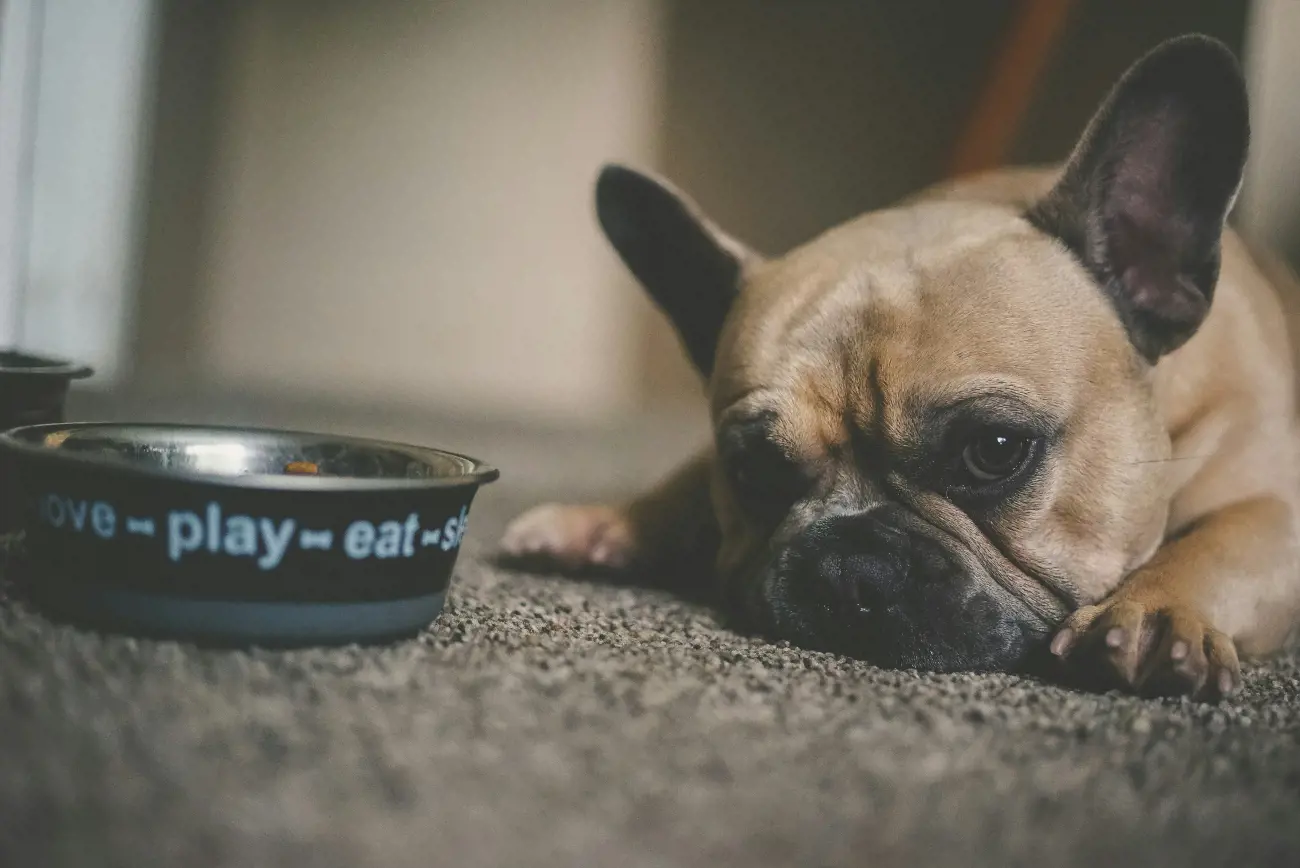
How much chocolate can a dog eat?
28/02/25Pet Insurance Quote
- 98% claims paid *
- Claims paid directly to vets
- 24/7 vet video consultations
- Interest free monthly payments

